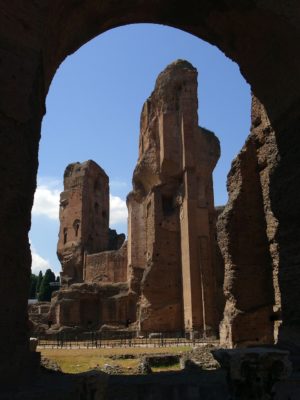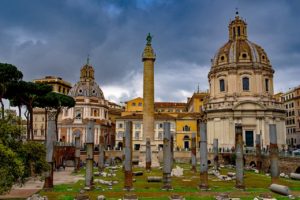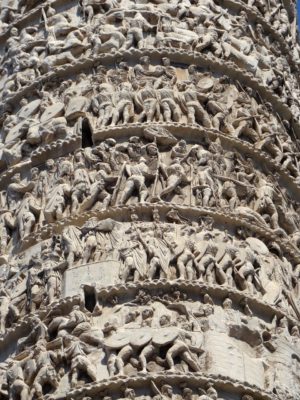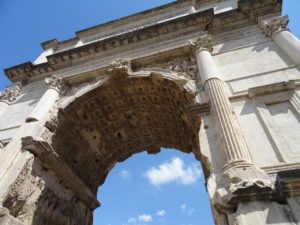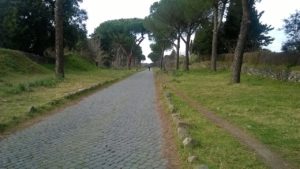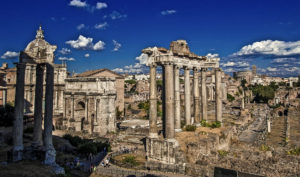
What follows is an interview with Professor Frank Korn. Now retired from Seton Hall University’s Classics Department, he has written for a variety of publications and has authored books, such as Hidden Rome, Below Rome, and A Catholic’s Guide to Rome, and more. He has traveled to Rome frequently during his lifetime, both professionally and for leisure.
Q. In Hidden Rome, you wrote about the Ara Pacis, one of the greatest monuments of ancient Rome, missing for centuries, found during the Fascist era. Can you tell us about this?
A. Of all his accomplishments, the emperor Augustus was most proud of bringing peace at last to a land torn by war throughout its then 700 years of existence. This was the start of what future historians would call Pax Romana, an era of peace and stability that would span almost two centuries. And so the Senate soon raised an altar, calling it the Ara Pacis, The Altar of Peace, to honor their esteemed leader.
In his memoirs, Augustus tells us of the monument. This shrine must have fallen victim to one of the many sacks of Rome by the barbarian hordes after the fall of the empire. All traces of it – even its location – was lost throughout the Middle Ages. In 1859, during renovation on a Renaissance edifice – the Palazzo Fiano – workmen discovered numerous slabs of carved marble which many scholars identified as fragments of the Ara Pacis. In 1937, by order of Mussolini, the site was thoroughly excavated bringing to light extensive portions of the peace shrine. These were ultimately reassembled on a platform erected near the Tiber where we can view and admire the monument in our time.
______________________________
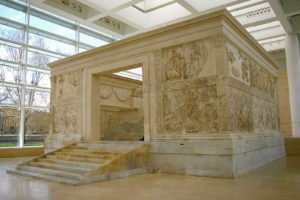
The Ara Pacis. teldridge+keldridge, Creative Commons Attribution 2.0 Generic license, Wikimedia Commons
______________________________
Q. The Tomb of Caesar Augustus is massive. Can you tell us about its history and mystery?
A. As far back as a quarter century before the Christian era, Augustus commissioned construction of a massive mausoleum to serve as the final resting place for himself, his family, and his successors. Marcellus, his beloved nephew, was the first to be entombed there. He died of malaria in 23 BCE at the age of 19. Had he lived, he would have been his uncle’s successor. Augustus’ son-in-law and great friend Marcus Agrippa was laid to rest there a decade later.
The historian Strabo gives us this description of the tomb: “A huge rotunda rising on a gigantic square base, both of pure white marble richly decorated and landscaped with cypresses…” The cypress was adopted from the Etruscans as a symbol of mourning. Flanking the entrance were two towering obelisks brought to the imperial capital from Egypt on order of Augustus.
Even in ruins, which we see today in the Campus Martius, the tomb of Augustus is impressive and imposing.
Q. Years ago, I recall staying in a convent hotel across from the Circus Maximus and walking around what’s left of the racing area. You wrote that the Circus Maximus sat 385,000 spectators and that Romans had “Hippomania.” What does that mean and what was this rowdy place?
A. Hippos in ancient Greek means horse; mania means frenzy, enthusiasm, mad passion. “Hippomania” is a neologism for the ancient Romans’ zest for horse racing. In the sixth century before Christ, Tarquinius the King took advantage of the oblong valley between the Palatine and Aventine hills to build a race track for horses. He ordered wooden grandstands to be constructed on the slope of each hill, and a dividing island – also of wood – to be laid out through the center of the valley. The starting gate was placed at the southern end of the 620-meter-long oval race track. Thus was born the prototype for all horse-racing stadia ever since. By the time of Caesar Augustus the arena had been transformed into stone, travertine to be precise. The dividing island, or spina, was made into a showpiece of sculpture and architecture, centered by a lofty obelisk brought from Egypt. The grandstands could by now seat 385,000 roaring spectators.
Under Augustus there were over 300 racing days a year, with a daily card of twelve races. There were four stables or horse farms that sponsored the events. These stables were known as the Reds, the Greens, the Whites, and the Blues, from the colors of the garments worn by their respective riders.
Heavy betting was rampant. There were numerous race courses – called Circuses – in and around the city. This was the main and largest one. Hence the name: Circus Maximus.
______________________________
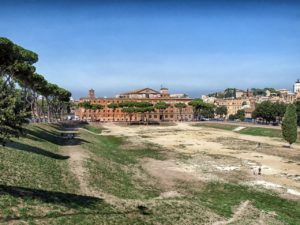
The Circus Maximus as it appears today. Pixabay, Public Domain
______________________________
Q. Even today, the ruins of the Baths of Caracalla are massive. Can you tell us about this “elaborate country club complex”?
A. Each July and August across more than five decades in the last century – until massive budget cuts in the 1990’s – the Rome Opera Company would stage Verdi’s Aida and other spectacular music dramas within the brooding ruins of the third century Baths of Caracalla.
Eighteen centuries earlier the sounds here were much different. The cavernous halls of the tepidarium (warm room), the calidarium (hot room) and the frigidarium (the cold room) rang with the cacophony produced by the whistling, hooting, jeering, laughing, and ribald singing of hundreds of bathers bent on having a good time.
But there was much more to this bathing establishment which served as a kind of ancient country club – a place to meet friends, stroll the landscaped grounds and chat, play ball, work out, get a massage, have drinks, enjoy dice games in the conference rooms, and so forth. Imperial Rome’s jet-set crowd would pull up to the entrance in closed litters. The “have-nots” arrived on foot, believing that any inconvenience or discomfort was well worth while just to escape, for a few hours, the dreariness of inner city tenements. A local ordinance scheduled different times for men and women in order to prevent mixed bathing. Every now and then there were violations of the law, resulting in scandals that became the talk of the town.
_______________________________
_______________________________
Q. You quote Percy and Shelley, who had great joy wandering around the Bath’s ruins. The Romantics loved ruins. Do you and your wife Camille get a special feeling being around ruins? What’s the aesthetic, the message?
A. Camille has been my treasured companion on most of my one hundred and seven trips to Rome across the last fifty two years. Some of these trips were for full semesters, some for a fortnight, some for an in between length. Like Shelley, et. al., we love visiting the relics of “the glory that was Rome”. In the ruins of the Augusteum, the mausoleum of Caesar Augustus, we can’t help but reflect for moments on end that there once rested here the ashes of that restless, gifted man who “found Rome a city of brick and left it a city of marble”. Down in the great Forum, amid the fallen columns and ubiquitous weeds, we never grow blasé about trodding the original paving stones of the Via Sacra that felt so often the sandal-shod feet of the consuls and senators, and the ordinary cives Romani.
Q. Trajan’s column depicts the machinery of war and conquest. What are the particulars about this column? It would scare any potential enemy, wouldn’t it?
A. The Column of Trajan, at one end of the forum named for that much accomplished ruler and city planner, was raised amid great panoply in the year 113. The bands of bas reliefs circling up the full height of the slender monument – 125 feet – represent Trajan’s triumphs over the Dacians beyond the Danube. Tiny windows illuminating the spiral staircase inside are almost concealed among the carved figures of soldiers, weapons, and p.o.w’s.
The column was originally topped with a statue of the emperor, facing the Forum, the Colosseum, the grandeur of Rome. The effigy stood there majestically through the ages until Pope Sixtus V (1585-90) replaced it with a likeness of St. Peter, facing the Vatican in the opposite direction. With the apostle’s back turned on the ancient splendor, Sixtus has Peter declaring: “Roma pagana est mortua. Viva Roma Christiana!”
_______________________________
_______________________________
_______________________________
Q. You wrote that the Romans brought twenty-two obelisks from Egypt and that thirteen are still pointing at the sky. Did the Romans have Egyptomania?
A. While I would not go so far as to call it “Egyptomania,” the Romans seemed to be curious about the culture and custom of the province they called “Aegyptus”, and by the exotic beauty of its women. They, the Romans that is, could relate to the Egyptians also because both peoples were polytheistic and saw religion as a civic duty. Both, at times, deified their rulers. Furthermore, Egypt is mostly in Africa, that mysterious continent, except for the Sinai peninsula which is in Asia.
Pliny the Elder, in the first century of our era, was fond of saying “Ex Africa, semper aliquid novi” – Out of Africa always comes something new – probably alluding to a passage from the writings of Aristotle who was likely referring to the numerous forms of wild life, principally in Libya. Could Pliny, now that it was a Roman province, have also had Egypt in mind? One wonders. Another indicator of Romans being somewhat intrigued by that land and its people is a curious monument in Piazza della Minerva. Here where once stood a temple to that goddess of war, the sculptor/architect Bernini in 1667 placed a statue of an elephant surmounted by an obelisk with a Latin inscription claiming that it would take the strength of that enormous beast to sustain the wisdom of the Egyptians.
Q. Before my first trip to Rome, you recommended Santa Prisca, on of the few house-churches mentioned in the New Testament. Today it’s a small, lovely church on the Aventine Hill, and one of its treasures lies under the church: the Mithra ruins. Can you tell us about all this?
A. Late in his reign, the emperor Claudius ordered the expulsion of all Jews from Rome. Among the exiled multitude was a pious couple, Aquila and his wife Prisca, who sought asylum in Corinth where they crossed paths with the apostle Paul. Under his influence the couple converted to Christianity. When Claudius’ edict was at last rescinded, they returned to their home on the Aventine Hill, and allowed their residence to be used as a place of Christian worship, one of the two dozen or so domus ecclesiae, i.e. house-churches, in the city of Rome.
We know this from a line in Paul’s letter to the Romans (16:3-5) which reads: “Give my greetings to Prisca and Aquila and to the church that meets in their house.” When Constantine ended the persecutions in 313, the Christian community erected a new church building on what was left of the original house and called it the Church of Santa Prisca. (Whenever I am back in Rome, the priests there invite me to do the readings at Mass.)
In 1933, during excavations to find the rooms of the original structure, archaeologists discovered that there had once been a Mithraeam on the site in pre-Christian times.
Q. Also, can you tell us about San Clemente and what’s below?
A. Christian pilgrims to Rome, hoping to be swept back across a million yesterdays to apostolic times ought to make their first stop at the church of San Clemente, just four blocks down on the Via San Giovanni in Laterano from the Colosseum.
San Clemente tangibly peels away the centuries, for it is actually three churches superimposed one upon the other with massive stonework and piles of masonry from three distinct Roman epochs. On this site, Christians have gathered for worship across two millennia.
When Peter was serving as bishop of Rome there dwelt here a pious priest named Clement who allowed his residence to be used as a house-church. In the year 88 Clement was elected to the throne of St. Peter, becoming the fourth pope of the infant church. In the late fourth century the faithful filled in the ground floor of Clement’s home with rubble and mortar to provide a bedrock foundation for the basilica they would soon raise there. The basilica was given the name San Clemente. Throughout the Middle Ages, it remained one of the most prominent of the city’s Christian shrines. In 1084 it fell victim to the Norman sack of Rome.
In 1108 Pope Paschal II constructed a new basilica on the remains of the fourth century structure. Today it is possible to visit all three levels.
As at Santa Prisca’s, a Mithraeum was uncovered here, too. In the center is a block of marble with a relief showing the god Mithras sacrificing a bull.
Q. Can you tell us about this Mithra religion? Also, why did it come to Rome? And can you tell us about the Isis religion in Rome?
A. Before the gospels reached the banks of the Tiber, a middle eastern cult known as Mithraism had taken root in the Capital. This centered about the worship of Mithras, an Indo-Iranian divinity associated with light and the sun. The earliest devotees claimed that since evil spirits ever lie in wait for hapless man, Mithras had come into the world as man’s friend and savior. Unlike the mainline Roman cults, Mithraism preached the immortality of the soul and urged a perpetual quest for personal sanctification, in an ongoing preparation for a spiritual life of bliss in eternity. It also called for new values and a fresh approach to terrestrial existence. Instead of gravitas, the typical grim view of life, there was to be a quiet joy. Mithraists were also expected to practice asceticism, self-control, and a fierce resistance to all impurity and decadence.
Mithraism, at least in the Roman world, found its most ardent followers in the military. Roman legions propagated the cult throughout the empire.
With the spread of Christianity in the late fourth century, the eastern religion of Mithraism began to be suppressed. In 377 the prefect of Rome, Gracchus, delivered the coup de grace with his orders to destroy all mithraea.
Q. Can you tell us about the Quirinal Hill and Esquiline Hill?
A. Il Quirinale, the Quirinal, is one of the original seven hills of Rome, all enclosed by the ancient Servian Wall. It takes its name from a temple to the Sabine god Quirinus which was later adopted as a Roman deity. The temple crowned the summit, where since the fourth century rises the patriarchal Basilica di Santa Maria Maggiore, so called because of all the Eternal City’s nearly seventy churches honoring Mary — this is the major one.
The ancient temple was, in the eighth century BCE, renamed the Temple of Romulus Qujirinus following the apotheosis of Romulus, mythical founder of the city. To this shrine there was assigned a special priest –- the Flamen Quirinalis — among whose duties was to preside over the sacred rites to the divinity each February 17, the feast day called Quirinalia.
In the neighborhood of the temple, in the late Republic and throughout the Imperial era, could be found many fine estates of the Roman elite.
The Esquiline Hill’s etymology has many versions. One I find fairly plausible is “ex colere” (to live outside) suggesting that much of the hill stood outside the circuit of the Servian Wall, at least early on. This hill was an amalgamation of the beautiful and the ugly. In the upper reaches were some fine residential areas lined with trees, especially umbrella pines. Down lower on the slopes was the dreaded Suburra, a slum of great squalor with a high crime rate. The satirist Juvenal wrote that no man should walk in this area of the city after dark without having first made out his will.
Q. You write about the area in Rome called Largo Argentina. Did the Fascists order that area excavated? What did they find?
A. Largo, like the word piazza means a city square. One such place in Rome is called Largo Argentina. Unlike the Eternal City’s celebrated piazzas with their splashing fountains, sidewalk cafes, strolling musicians, and a baroque church or two, Largo Argentina offers only crawling traffic and urban din. One redeeming factor is the Teatro Argentina with its peach facade and this inscription to the appropriate Muses:
ALLE ARTI DI MELPOMENE D’EUTERPE E DI TERPSICORE
But the main attraction of the square is the sunken area in the center, some twenty five feet below the current street level, featuring the special remains of four temples from the early Republic. Discovered as recently as 1930, these shrines are so ancient that archaeologists soon realized that they had been submerged beneath the stratification of Rome so long ago that even Caesar Augustus likely had never seen them. The deities to which these temples were dedicated are as yet unidentified.
When Mussolini learned of this discovery he ordered further extensive digging at once. Thus the classical world owes Il Duce somewhat of a debt of gratitude.
______________________________
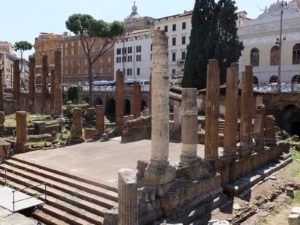
Temple A in Largo Argentina. Amphipolis, Creative Commons Attribution-Share Alike 2.0 Generic license, Wikimedia Commons
______________________________
Q. In your writing on Pagan Rome, you included the dinner party, which Petronius wrote about. So, it was a lot of excess food and wine, but also it had a somber theme about the transitoriness of life. Can you tell us about these feasts? Is the evidence all literary or is there some archaeological evidence?
A. In that long ago era of no radio, no television, no I-pads, nor I-pods, an invitation to a dinner party was one of just a few things to look forward to for a Roman evening. And that treat was only for the well-to-do.
In his witty novel, Cena Trimalchionis, the first century writer provides a glimpse of the lavishness of the food and the opulence of the setting at such gatherings. The principal part of the meal followed an hors d’oeuvres hour and was concluded with a session of drinking and levity, which the more dissolute among the guests prolonged until dawn. In the course of the clamorous get-togethers there would customarily be music, singing, dancing, and various parlor games. This was the authentic time for winding down from the stresses and annoyances of the day.
Every host was eager to make a show of his financial status via plush room decorations, expensive dinnerware, and exquisite objets d’art. We learn all this mostly from ancient writings and particularly from archaeology. During the early excavations at Pompeii, in the so-called House of Menander, a stunningly beautiful set of pure silver dinnerware – 118 pieces – was unearthed. In other Pompeiian homes we see paintings depicting formal suppers and an occasional well-preserved triclinium, dining room with a sloping couch ranged on three sides of a square table, the other side open for the servants to bring course after course after course. The paintings and the layout of the room, and the word triclinum show that the Romans did not sit, but rather reclined at the table.
One more little curious note: as the guests arrived they would find at the entrance to the dining room a slave calling out “Pede dextro, quaeso”, Right foot please! An old superstition held that by putting one’s left foot first over the threshold was to jinx the whole evening from the very start.
Q. Can you tell us about some of your favorite arches, gates, aqueducts and anything else you’d like to add?
A. As for triumphal arches in Rome, our favorite is the Arch of Titus which honors his conquest of Jerusalem and provides the ceremonial entrance into the Forum. In a remarkable state of preservation, the arch features many beautifully carved bas reliefs. One shows the triumphal parade with soldiers bearing some of the spoils of victory among which is an enormous Menorah, the seven-stemmed candelabrum taken from the great Jewish temple. What a compelling testimonial to the old maxim: Ars longa, vita brevis. The sculptor, whoever he was, has been dust for two millennia, while his splendid carvings live on.
Still clearly engraved on the tympanum are the words: “Senatus Populusque Romanus. Divo Tito Divi Vespasiani F.” — The Senate and the Roman People to the Divine Titus, Son of the Divine Vespasian. Upon their deaths both emperors – father and son, were deified.
Our favorite gate is the Porta Latina, just inside of which is the fourth century church with the poetic name of: St. John at the Latin Gate.
Of the ancient water-works we prefer the Claudian Aqueduct (4th century BCE) under whose arches our three sons – as little boys – used to play hide and seek with their Roman pals, out in the counrtyside.
_____________________________
_____________________________
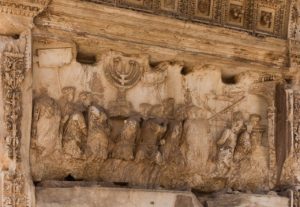
Iconic scene of the triumphal march of soldiers carrying the great Menorah captured from Jerusalem, a bas relief carved upon the Arch of Titus. Pixabay
_____________________________
Q. Can you tell us about the most important roads, such as the Via Appia or Appian Way?
A. An old saying claims: “All roads lead to Rome.” Today’s civis Romanus put it this way: “Tutte le strade portano a Roma.” This can be taken not only figuratively but also literally. All the great highways that the gifted Roman road builders constructed lead from a multitude of points in the far reaches of Italy inexorably to the capital.
The oldest of these, the Via Appia, opened to traffic in 312 BCE by the consul Appius Claudiuis, and named for him was the great south road, linking Rome with the Naples area. Terminating in a suburb called Capua, the road proved so convenient it was extended all the way to Brundisium on the Adriatic Coast. The people called it Regina Viarum, the Queen of Roads. Once trafficked by iron-wheeled chariots and horse-drawn delivery wagons, the original paving stones remaining in some stretches are now caressed by the rubber tires of the modern automobile. Other routes in the ancient highway network bear names like: Via Latina, Via Ostiense, Via Salaria, Via Aurelia, Via Cassia, Via Flaminia and so on.
____________________________
____________________________
Q. The catacombs – it’s a fascinating journey on ancient roadway just to reach them. What are they and who’s buried there?
A. The catacombs are those subterranean cemeteries of the early Christians and Jews in Rome. In fact, it was the city’s Jewish colony which first conceived of the idea of tunneling the subsoil outside the walls to provide burial grounds for their loved ones. There were eventually dug – across the first four centuries of our era — some seventy such Christian sites and a much smaller number of Jewish ones.
Because of a law forbidding burial of ashes and bodies within the ancient city fortifications, all of these cemeteries lie beyond them, along the roads leading out of Rome. Three of the largest –- the Catacomb of St. Callistus, that of St. Sebastian, and the one called St. Domitilla — are located along or near Via Appia as are the Jewish cemeteries, both under vineyards, the Vigna Randanini and the Vigna Camarra.
A catacomb (so called from the Greek Kata (down) and Kumbas (in the hollows), is a labyrinth of tunnels – some ten to twelve feet in height and about three feet in width – with niches of varying dimension one above the other, carved out of the walls. In these recesses, called loculi, were placed the bodies, usually wrapped in linen according to an ancient Jewish custom. The loculus would then be sealed with bricks or a slab of marble – depending on the financial status of the bereaved family.
The bricks would soon be covered over with a layer of plaster into which would be etched – or on which would be painted – the name, the age, the date of entombment, perhaps the occupation or some other details of the deceased.
These epitaphs tell us much about life back then about the family bond, about religious beliefs, about the hope of an after-life, about the average life span, about the sad high rate of infant and child mortality, about the invocation of saints – particularly Peter and Paul – and especially of martyrs. Many of the inscriptions are in Greek, for that was the liturgical language of both Christians and Jews in old Rome.
After a burial, the grieving family would often hold a refrigerium (cold meal) in honor of their lost loved one. This was the forerunner of the modern custom of a repast. Some families were affluent enough to afford not merely a niche but a small room (cubiculum) for their burials and often allowed the less fortunate mourners to use the room for their refrigerium.
_____________________________
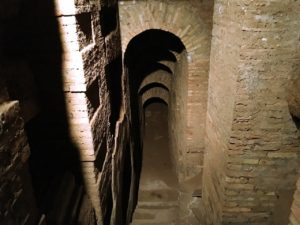
What lies beneath — A view within the ancient Roman catacombs. George Syrios, Pixabay
_____________________________
Q. What movie, in your estimation, depicts Rome’s ruins and grandeur best?
A. Most of the Hollywood productions set in Rome that I have seen feature the usual popular tourist sites, e.g. the Colosseum, the Spanish Steps, Trevi Fountain, Piazza Navona, Villa Borghese, the Via Veneto, et cetera. I don’t recall any showing the Roman Forum, the Circus Maximus, the Baths of Diocletian and those of Caracalla, or the funeral monuments along the Appian Way, or Largo Argentina, etc.
While I have not seen the much acclaimed film, “The Gladiator,” I am told that it does an excellent job of showing the grandeur that once was Rome.
Q. What is a must-read essay or book from ancient Rome that has a profound message for those who love history and archaeology?
A. Of these there are several that I can enthusiastically recommend, such as the satires of Juvenal, the Annuales by Tacitus, the Commentaries on the Gallic Wars by Julius Caesar, among numerous others.
For a glimpse of the political and social goings-on of the late Republic, I eagerly suggest the six volumes of Cicero’s correspondence with the movers and shakers of the day and with his alter-ego, Atticus. For an eyeful of family life, leisure interests, luxurious country villas, attachment to one’s home town, etc., the letters of Pliny the Younger make delightful reading, as does his eye-witness epistolary account of the burial of the decadent city of Pompeii by the eruption of Vesuvius. I’ve always found it fun to study history by opening someone else’s mail.
As for the importance of studying history I would refer you to Cicero’s quote: “He who does not know what took place before he was born, remains forever a child.”
As for the value of archaeology, of laboriously digging up the past, I like what one archaeologist told me: “I dig to find out who I am”.
Cover Image, Top Left: The Roman Forum. StevoLeBlanc, Pixabay
____________________________
About Frank Horn
Frank is retired from Seton Hall University where he was an Assistant Professor of Classical Studies. He is the author of nine books, such as Hidden Rome and A Catholic’s Guide to Rome. He was a Fulbright Scholar at the American Academy in Rome, and he won the Princeton Prize for Distinguished Teaching.
Richard and his family happened to meet Frank (the interviewer) and Camille Korn at Pinho’s Bakery in Roselle, NJ. They soon realized the connections they had going back two generations. When she attended Benedictine Academy, Bonnie Marranca (Richard’s sister) wrote Frank a fan letter having to do with Rome and the study of Latin. Frank had written articles in local papers that informed and inspired countless readers.
Frank and Camille have been to Italy about sixty times and have also taken groups there. Frank’s conversation and writing, based on his travels and his life-long study of the classics, capture the magic and beauty of Rome.
About the interviewer
Richard recently conducted interviews of Egyptologists Salima Ikram and Kara Cooney, published in Popular Archaeology. In the last year, he has authored stories published in Coneflower Café and The Raven’s Perch; poetry in The Paterson Literary Review; and his book, Speaking of the Dead, has recently been accepted for publication by Blydyn Square Books in NJ.
He has taught English and the humanities for over a quarter-century, culminating in a Fulbright to teach at LMU in Munich. He also has been awarded six NEH summer seminars. He and his wife Renah and child Hera also make travel and educational videos under the heading Childe Hera’s World. Their hobbies are yoga, hiking and travel. _______________________________
Advertisement

